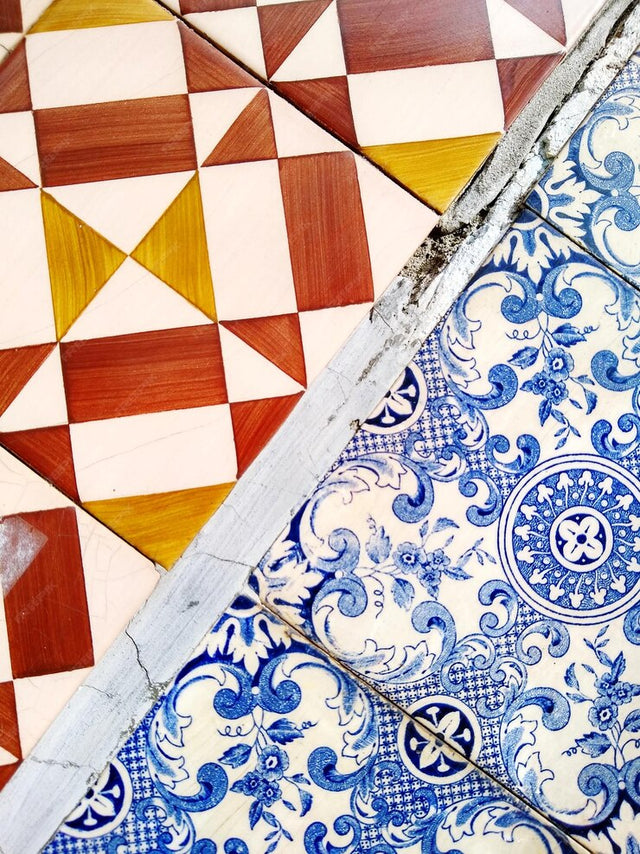The origins of ceramic tiles in ancient civilizations
Ceramic tiles have been present in our world for hundreds, if not thousands of years, originating from ancient civilizations. Various civilizations over the centuries have paved the way for the use of ceramic tiles in their architecture, imprinting their history both in clay and in culture. The importance of ceramic tiles for ancient architecture cannot be overstated. We can distinguish three main civilizations that paved the way for the introduction of ceramic tiles in their architecture:
- The Egyptians - 4000 BC, made a significant contribution to the development of ceramic tiles. They used them to create mosaics and decorations inside pyramids and other monumental buildings.
- The Greeks - 3000 B.C., introduced ceramic tiles in their homes as symbols of social status. Their designs reflected Greek mythology, creating beautiful and colorful patterns.
- The Chinese - 1,500 years BC, developed more advanced techniques for the production of ceramic tiles, which allowed for mass production. They combined art with functionality, introducing ceramic tiles into architecture on a scale never seen in any other ancient civilization.
The ceramic tiles not only reflect the richness and diversity of these ancient cultures, but also constitute a valuable part of the architectural heritage that has survived to this day.
Evolution of ceramic production techniques over the centuries
The production of ceramic tiles has always been associated with the evolution of techniques. Those that were initially used in ancient times were simple but effective. The Egyptians and the Greeks used natural raw materials, such as clay, to create handmade molds, which were then fired. However, the Chinese, already 1,500 years BC, began to introduce innovations, improving production techniques that allowed for mass production.
The development of technology has occurred over the centuries. In the Middle Ages, innovative techniques began to be used, such as viscous processing and scaffolding. The evolution of techniques was extremely dynamic, especially during the industrial revolution, when it became possible to introduce mechanical machines for the production of ceramic tiles. Starting from the 19th century, innovations allowed for the creation of tiles in large quantities while maintaining high quality.
- 19th century - introduction of industrial machines.
- 20th century: the use of enamel, which has significantly influenced the aesthetics of the final product.
- 21st century: the use of digital technologies to create non-standard tile models and shapes.
Today, the production of ceramic tiles is a complex process that utilizes the latest technologies, allowing for the creation of products with an extraordinary variety of shapes, colors, and patterns.
The rebirth of ceramic tiles and their role in art
The Renaissance is a period in which ceramic tiles began to play not only a functional role but above all a decorative one, becoming an integral part of the art of the time. They regained their splendor, becoming a precious decorative element in architecture and art. The motifs carved on them reflected typical themes of the Renaissance period, such as mythological and religious scenes and portraits. Even today we can admire wonderful ceramic works from this period - in churches, palaces, and museums.
One of the most beautiful examples of the use of ceramic tiles in Renaissance art is the works of majolica, in which artists like Luca della Robbia created stunning reliefs and figures in ceramics. Their works still illuminate the artistic environment today with their color and richness of details. This is a period in which ceramic tiles become not only a practical solution but also a form of expression of beauty and harmony, which were the fundamental values of the Renaissance. As a result, these types of materials have rightly been called masterpieces of art.
Modern applications and trends in ceramic tile design
The modern applications of ceramic tiles testify to an infinite creativity and the trends that arise from them are transforming contemporary architecture and interior design. Ceramic tiles, despite their roots dating back to antiquity, are today a key element of modern design, offering a wide range of applications: from flooring and cladding, to everyday objects, and even elements of applied art.
Innovations in design add a new dimension to ceramic tiles. A trend that is gaining popularity is the creation of tiles with irregular shapes, expressive colors, and even custom patterns. All of this makes ceramic tiles not only functional but also an important decorative element in any space. Considering the mentioned trends, it seems that the possibilities for creative use of these materials are virtually limitless. Thanks to this, architecture and interior design are constantly evolving, and the modern applications of ceramic tiles continue to amaze with their ingenuity and beauty.
Sustainability and the future of ceramic tiles
Sustainability has become an essential element of the modern world, and the ceramic tile industry is no exception. The impact of these decorative products on the environment is an increasingly discussed topic, drawing attention to an ecological approach to production and use. For the first time, the community is beginning to notice the need to seek durable and beautiful alternatives to traditional materials.
The main points of the ecological approach are:
- Reduce energy consumption in the production process by implementing effective technologies and heat recovery.
- Increase in recycling rates, both for raw materials and for finished products.
- Promote the sustainable and responsible use of ceramic tiles, aimed at extending their life cycle.
In this context, the future of ceramic tiles looks brighter, thanks to sustainable development and innovations aimed at reducing the negative impact on the environment. With the growing importance of sustainability, the industry is constantly seeking new eco-friendly solutions that help maintain harmony between aesthetics and care for the environment.








0 Comments
There are no comments for this article. Be the first one to leave a message!